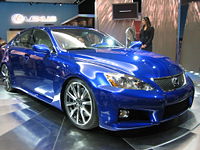 In 2006, several automotive publications reported on rumors of a higher performance variant of the IS being tested at various stages of development. Spy photos of such a vehicle being tested in Germany and California were published in several magazines and websites. Among these spy reports, several photos were shown of a heavily modified and camouflaged IS sedan at the Nurburgring test track in Germany along with other disguised Lexus test vehicles. The previous generation IS 430 prototype vehicle was indicative of future possibilities for the IS series, including the likelihood that a second generation high-performance IS model could come equipped with a V8 engine. It was rumored that there would be a coupe and a convertible version for a 2009 model, as well as a convertible version of the V8-powered IS.
In 2006, several automotive publications reported on rumors of a higher performance variant of the IS being tested at various stages of development. Spy photos of such a vehicle being tested in Germany and California were published in several magazines and websites. Among these spy reports, several photos were shown of a heavily modified and camouflaged IS sedan at the Nurburgring test track in Germany along with other disguised Lexus test vehicles. The previous generation IS 430 prototype vehicle was indicative of future possibilities for the IS series, including the likelihood that a second generation high-performance IS model could come equipped with a V8 engine. It was rumored that there would be a coupe and a convertible version for a 2009 model, as well as a convertible version of the V8-powered IS.
On 6 December 2006, Lexus officially confirmed the existence of the vehicle which they called IS-F in the press release. The IS-F sedan premiered at the 2007 North American International Auto Show on 8 January 2007 as the launch product of Lexus’ F-Sport lineup of performance-focused vehicles. The new IS-F features a 5.0 L direct-injected V8 producing 416 SAE hp (423 PS, 311 kW) at 6,600 rpm, while peak torque is 371 lb-ft (505 Nm) at 5,200 rpm. The engine also features a two-stage intake system, engine oil and transmission fluid coolers and an oil pump designed for high-speed cornering. Images were leaked a couple of hours before the official announcement.
At its press debut, Lexus revealed that a separate “skunk works” team designed the IS-F in a manner distinct from typical Lexus engineering efforts. The IS-F promises 0-100 km/h (0-62 mph) acceleration under 4.9 seconds. The vehicle featured an 8-speed automatic transmission with sequential shift, a new sport version of Lexus’ electronic stability control system (Vehicle Dynamics Integrated Management, or VDIM, featuring three distinct on-off modes), and was equipped with Brembo brakes stamped with the Lexus emblem.
Other design features included a four-passenger cabin with carbon-fiber panels, steering wheel paddle shifters, and 19-inch BBS forged aluminum alloy wheels. The vehicle body was lowered by 1 cm (0.5 inches) compared to the standard IS. Noticeable about the IS-F’s design are its quad exhaust tailpipes comprised of vertically stacked dual exhaust pipes on the left and right rear. Road & Track tested the IS-F in their January 2008 issue, attaining a 0-60 mph time of 4.4 seconds, a slalom speed of 71.2 mph (0.3 mph adrift of a Porsche 911 Carrera 4S), and an electronically limited top speed of 170 mph.
In October 2007, the IS-F premiered in Japan, with a 500-unit yearly target for that country, and a 5,000-6,000 yearly unit target for the U.S. market. Top speed was listed at 168 mph. An earlier Autoweek item had speculated that Lexus may build only 1,000 IS-Fs for the US market, and also suggested that the vehicle would have a top speed of 320 km/h (200 mph) (contradicting the generally accepted standard for this automotive class), which led automotive news sites to question the accuracy of their information. The editor and representatives of a major Lexus IS enthusiast website with Lexus press access further suggested that Autoweek’s report may be referring to the LF-A supercar, which Lexus did indicate could reach 200 mph. In 2007, the head of Lexus GB stated in an interview that 150 IS-Fs would be allocated for the UK market.
Filed under: Cars, Lexus, Luxary, Speed | Tagged: autos, buy a car, Cars, Lexus, Lexus IS-F, Luxary, Speed, used cars | Leave a comment »




